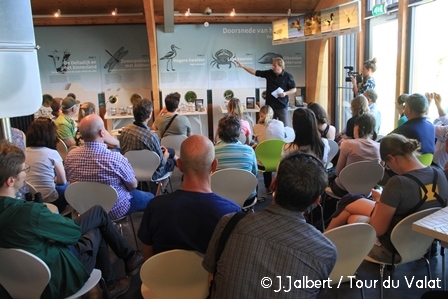A study tour was organised from 18 to 20 April by the “Dutch Coalition for Natural Climate Buffers” and Eurosite, the European Network of natural area managers, to discover the various “nature-based solutions” for adapting to climate change in the Netherlands. This is a major challenge in this country of 17 million people where 55% of the landmass is below sea level!
Whereas the knowledge and hydrological expertise of the Netherlands are acknowledged throughout the world, given the catastrophic climatic events that have occurred recently, water management stakeholders have become aware of the limitations of hydrological technologies alone. Taking account of the expected effects of climate change, and thanks to the active contributions of environmental stakeholders, they have gradually integrated “nature-based solutions,” which can respond to multiple challenges, such as the safety of inhabitants and biodiversity, and farming or recreational activities as well as ones.
Organised within the scope of Eurosite’s “Wetlands and Climate Change Working Group,” chaired by Jean Jalbert, General Director of the Tour du Valat, the aim of this study tour was to share these innovative approaches.

Specialists from Natuurmonumenten, the principal environmental NGO in the Netherlands, and various other organisations welcomed around 40 people from 12 European countries, and made them discover 6 projects that illustrate various facets of these “natural climate buffers.” From the Rhine basin to the Wadden Sea, from low peatlands to sandy plateaux in the north-eastern part of the country, a variety of approaches was unveiled, such as restoring natural areas so they can store water and in this way preserve urban and farming areas, moving dykes to open up some free space for rivers and mitigate flooding, restoring coastal salt marshes and reviving their sediment dynamics to offset the rising sea level, and re-establishing hydrological connections for migratory fish.
Integrated nature conservation, climate adaptation and water management objectives were established for each of these projects, which associated the principal stakeholders and were incorporated in the local socio-political context.

But beyond the pertinence of the management of each site, it is the remarkably coherent and complementary nature of the approach that stands out, permitting cumulative beneficial effects from one catchment area to another.
The final event in this study trip was an ideas workshop during which the interests of these approaches were discussed. The participants unanimously agreed that it is urgent to promote these climate buffers as widely as possible throughout Europe. Various initiatives of this kind were identified and the broad lines were sketched out for the development of a project that could be backed by Eurosite in a partnership with several of its members, with an application for funding to be submitted within the scope of the Life Climate projects.
In addition to chairing the Eurosite “Wetlands and Climate Change” working group, the Tour du Valat is planning to be significantly involved in the development and implementation of “natural climate buffers,” particularly in the Mediterranean region.